The Golden Hour of the Wounded Soldier
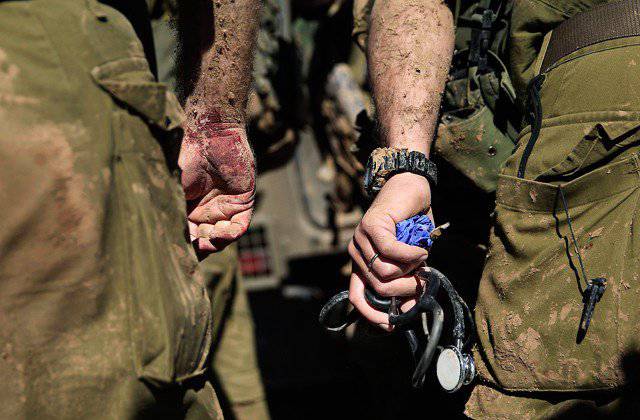
How does Israeli field medicine work
In military medicine, there is a key concept of the “golden hour” to assist the wounded on the battlefield: if full medical assistance is provided within the first hour after being wounded, it will save the lives of 90% of injured soldiers. The delay of death is similar - the delay in providing assistance for only two hours leads to the fact that the number of survivors after injury quickly falls to 10%.
The military medical service of the Israeli army is rightfully considered one of the most advanced. She recently improved the system for saving the lives of the wounded on the battlefield, reducing the “golden hour” to 43 minutes, which led to a marked increase in the number of saved lives. So, if during the Doomsday War in 1973, up to 35% of wounded soldiers died, then during Operation “Enduring Rock” in July-August of this year, the irretrievable loss among the wounded did not exceed 6%.
Doctor on the battlefield
Israel believes that the problem of the “golden hour” can be solved only as a result of a radical change in the entire multi-level structure of care for the wounded. Everything is important here: individual first-aid kits, dressing facilities, medical equipment, time and methods for evacuating the wounded.
However, the experience and knowledge of the military physician, who is able to assist in the first minutes after being wounded, is crucial in saving the lives of the wounded, and therefore the military doctor must go into battle with the soldiers. When a doctor who knows what to do is two minutes from the wounded, it changes the course of events.
In the framework of the traditional scheme in which military doctors work in the armies of most countries of the world, paramedics and orderlies usually provide first aid on the battlefield, and then a lot of time is spent on evacuating the wounded to the rear. The injured die or go to hospital in a state where medicine is already powerless. This is because with most combat wounds very quickly, in just 5 — 10 minutes, a serious and deadly complication develops — shock. It leads to respiratory failure and cardiac activity. Another danger is blood loss: in cases of severe arterial bleeding, a person can bleed out in 10 — 15 minutes.
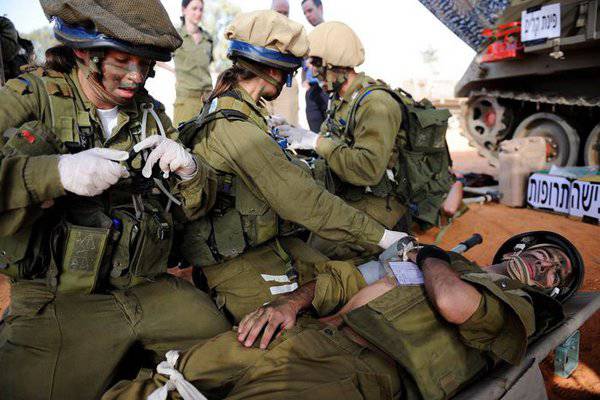
In Israel, these problems are solved in many ways, but the key solution is to provide highly qualified medical assistance right on the battlefield. The military doctors are directly in the combat formations of the fighting units and come to the rescue already in the first minutes after being wounded.
A military doctor on the battlefield can do a lot. A military doctor, captain Alexei Kalganov, tells us twice that he won awards for courage shown in saving the lives of the wounded on the battlefield. In peacetime, Aleksey Kalganov is a leading orthopedic surgeon in an Israeli hospital, and during the fighting he, like other Israeli doctors, is drafted into the army.
“We covered our special forces, who fought. Four soldiers were seriously injured. One bullet landed in the mouth. I looked - all airways are ruined. I thought he was dead, but the pulse was still palpable. I quickly inserted a tube into the throat, pumped blood from the lungs, and we evacuated it along with other wounded people. In truth, I had no doubt that he was not a tenant, and he not only survived, but almost completely recovered. All decided some seconds. He was just lucky that he was not just a doctor, but a surgeon. ”
Major Pavel Kataev, a military doctor, was assigned to an infantry battalion that fought in Gaza during Operation Cast Lead in January 2009. “That night we were in a building next to a house that was accidentally hit by two of our tank projectile. Naturally, as soon as the radio reported on the multitude of casualties, we rushed there and arrived even before the dust settled from the explosion. The picture was as follows: all the commanders were wounded, there was no one to command the military, the soldiers were shooting in all directions from all windows and miraculously did not hit us.
In the first few minutes, it was harder to command both soldiers and provide medical assistance. Many soldiers lie, a lot of blood, moans, screams, shooting. The first thing I did was to stop the fire, carefully lower all the wounded down and take positions in the guard, guarding the building and not shooting without any reason. All this happened for maybe no more than a minute, but it seemed like an eternity. There were more than 20 victims, three killed, which we could no longer help, eight seriously wounded, among them Ben Spitzer, who had both hands torn off and legs crushed. We immediately began doing surgical and resuscitation procedures to save their lives. Then I contacted the head of the medical service of the Southern Military District, reported to him about the condition of the wounded, specifying which specialists, such as microsurgeons, should be urgently prepared in hospitals to receive the wounded, since every minute can be decisive.
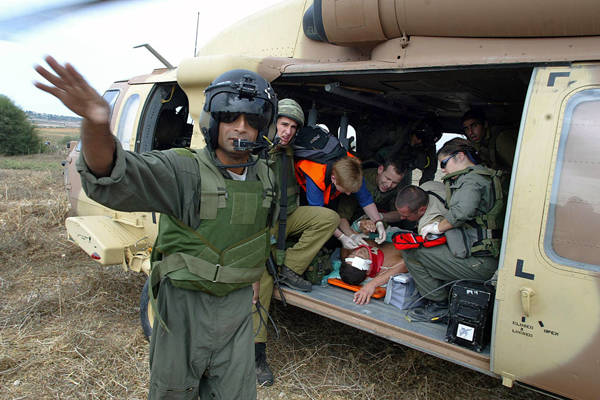
As soon as they let me go home after the end of the fighting, I first went to the hospital, went to the intensive care unit to Beni, saw that they had sewn his hands (unfortunately, only one got accustomed, I had to amputate the second one) that the legs are in place, and sighed with relief. "
A military doctor on the battlefield risks his life on a par with soldiers and officers of combat units. Military doctor captain of the reserve Igor Rotshtein was urgently mobilized on July 24 of the year 2006. He was seconded to the 13 Battalion of the Givati Infantry Brigade, in which he entered Lebanon. Rothstein was an experienced military doctor: for five years he served as a battalion doctor in the Southern Military District, took part in hostilities. After demobilization in 2004, he worked as a surgeon at Poria Hospital in Tiberias.
On the night of August 4 2006, in the area of the village of Markabe in southern Lebanon, Rotstein died in battle, saving the life of a wounded soldier. A torn shell wounded a soldier. The doctor hurried to help the wounded man, and the next shell covered them both.
Evacuation of the wounded under fire
An important reserve for the precious minutes of the “golden hour” is the use of modern transport for the quickest possible evacuation of the wounded from the battlefield to inpatient hospitals. Israeli experience shows that the most effective means of evacuation are helicopters and tank bullets - “Merkava” tanks, equipped with mobile first-aid posts and equipped with additional armament. Such armored ambulances showed themselves particularly well in rescuing the wounded under enemy fire. Thus, during the war in Lebanon in the 2006 year, the Israeli Air Force helicopters performed about 120 evacuation flights, approximately half of them - on the enemy territory, where the evacuation took place under enemy fire. On these sorties, they removed a number of wounded to 360.
The helicopters were equipped with the necessary medical equipment, military doctors and paramedics who provided qualified medical assistance directly on board the helicopters were included in the crews. The evacuation of the wounded by air from the battlefield to the hospital lasted an average of about 3,5 hours. In one flight, an average 4,5 soldier was evacuated. During the evacuation by air, not a single wounded soldier died.
During the war in Lebanon in July 2006, the military doctor captain Marina Kaminskaya was the head of the medical service of the tank battalion, in which she entered Lebanon on the first day of the war and took part in the battles for the settlements of Kanatra, Maroun ar-Rush and the city of Bint Jubail . Kaminsky fought on the tank bulanse. On it, she was in the thick of the fighting for Bint Jubail, a key location for the concentration of the Hezbollah terrorist group in southern Lebanon on July 24 on July 2006. To evacuate the wounded tankers and infantrymen from the battlefield, the command sent her tank bulans. The car was covered by two conventional tanks, one - directly, and the second - on the nearest approaches.
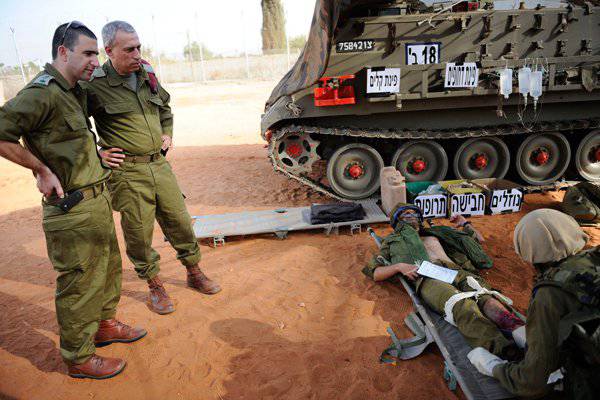
At the height of the battle, the wounded began to enter the tank bulan. Among them was an officer who was seriously injured - a bullet of an enemy sniper hit him in the face. Kaminskaya, right on the battlefield, gave him first aid and took him to the tank bulanse to the helipad, from where the wounded were taken by helicopter to the hospital in Haifa.
During the battle, a tank was shot down, covering it with a tank-bulance. Of the four crew members of the wrecked tank, the tank platoon commander was killed, two tankers were slightly injured. The battalion commander’s tank, which came to the rescue of the crew, was blown up by a land mine containing approximately 300 kilograms of explosives. Of the seven people in the tank — the crew members and officers of the battalion headquarters — the sergeant, the driver were killed, and the rest were injured.
Kaminskaya, despite the enemy's fire, provided all the wounded with medical assistance and successfully evacuated them in her tank bulan. In total, she saved the lives of more than 25 wounded soldiers during the fighting.
New technologies save the wounded on the battlefield
Any war is a kind of testing ground not only for new weapons, but also for the newest technologies to save the lives of the wounded. Operation "Enduring Rock" was no exception.
It is estimated that up to 80% of the wounded are killed due to blood loss. In the course of Operation Enduring Rock, the troops successfully tested a whole range of new technologies and medical devices, which made it possible to significantly increase the number of lives saved.
As the only way to stop the bleeding was used overlay harness. Now the Israeli army has abandoned the traditional rubber harnesses: now in the backpack of each soldier there is a “turnstile”, which is a 96-centimeter nylon sleeve with a harness inside, equipped with a handle. The handle is part of a device consisting of locks and velcro, using which a soldier can stop the bleeding by himself, even if he is wounded in the arm. Soldiers are taught to use the "turnstile" even on the course of a young fighter.
In cases when the “turnstile” is not suitable, for example, when amputation is high or a wound to the stomach, hemostatic dressing devices containing components that promote blood clotting and intended to stop external bleeding of varying intensity, including damage to large vessels, began to be used in the Israeli army. .
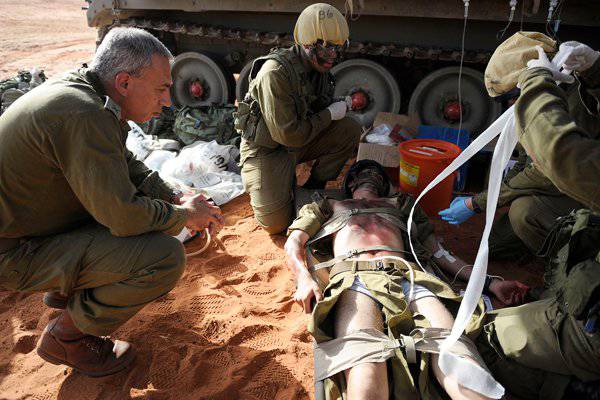
In addition to using these new hemostatic agents in the bag of every military medic, there are now ampoules of hexacaprone on the battlefield, accelerating the process of stopping bleeding.
With a large blood loss, military doctors directly in the battlefield inject a solution of blood plasma powder. The advantage of this technology is that, unlike portions of donor blood that require cooling or freezing, blood plasma powder can be taken with you on the battlefield. A package of plasma powder and a bottle of liquid is all that is needed to prepare a solution.
During the battles in Gaza, a new tool, such as a kind of zipper, reliably tightening open wounds, has been tested, but its use requires a fairly high qualification of military doctors.
A common cause of the death of the wounded is pain shock. Now all military paramedics have automatic syringes for injecting morphine, as well as a new tool - "aktik", based on fentanyl, a hundred times stronger than morphine. This medicine is placed under the tongue, and the pain disappears for at least an hour. The advantages of "aktika" include the fact that it not only alleviates the suffering of the wounded, but also does not lead to a drop in pressure, and this is one of the problems in using morphine and its derivatives.
Among the other medical innovations used to save the life of the wounded during the “golden hour”, Israeli military doctors are armed with a portable ultrasound scanner to detect internal bleeding in the field, an oxygen saturation meter to check the condition of the wounded, and a carbon dioxide detector to test the effectiveness of artificial respiration and fentatil lollipop to soothe sharp pains in a minute.
Information